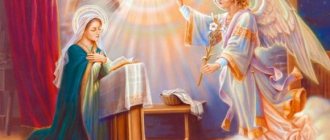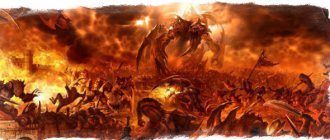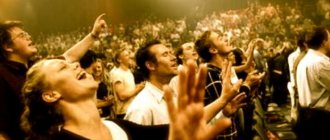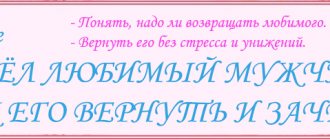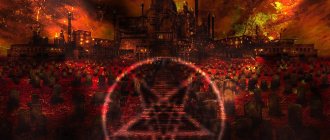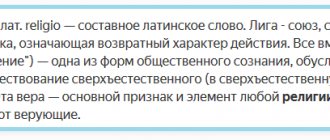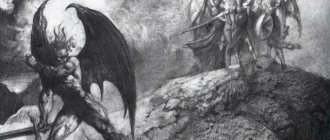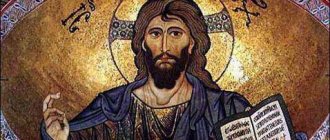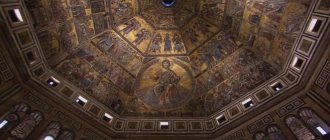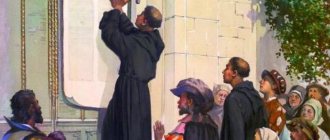Cherubim
- 1) angelic rank (degree of angelic hierarchy), belonging to the triad of higher angelic ranks (in patristic literature it is often listed after the rank of seraphim, but sometimes, in the list of angelic degrees, it is placed not in the second, but in the first position); 2) angels, representatives of this rank.
According to the interpretation of “Dionysius the Areopagite”, the name “cherubim” “means their power - to know and contemplate God, the ability to receive the highest light and contemplate the Divine beauty at its very first manifestation, their wise art - to teach and abundantly communicate to others the wisdom bestowed on them.” Meanwhile, other interpretations of this naming are known. It has been suggested that the Hebrew word kerubim in its plural form may be related to the Akkadian verb meaning “to bless, praise, pray.”
Meaning of the word
The origin of the word "cherub" is not precisely determined. Etymologists offer a number of theories:
- From the Semitic "to plow". The word describes an ox cultivating the soil. When applied to Angels, it characterizes a very powerful being.
- From Arabic "to inspire fear."
- From the Hebrew "cherub" - "to be close." This is a possible indication that Cherubim are the angels closest to the Creator.
- From the Semitic and Indo-European “to take”, which is associated with birds of prey - vultures, considered protectors of the golden mountains.
- From the Hebrew “to know”, “to understand”. These angelic forces have a very rich knowledge of God's personality, His plans and creations.
- From Aramaic “to cut”, “to depict”. This may mean that any earthly image of Cherubim is only a figment of human imagination, but is not connected with their real appearance .
- From the Akkadian “karabu” - “to bless”, “to pray”. This is a possible hint of their prayerful mediation between man and the Lord of all worlds.
Translated from Hebrew, Cherub means flaming, burning, fiery. The fiery love that these heavenly forces have for their Creator is considered the generally accepted version of the origin of the name.
Most of these theories contain only partial truth about the second order of angels. We learn much more about them from the messages of the Holy Scriptures.
Angels are the creatures closest to people - they help people take the right path.
Angels are the creatures closest to people. They help a person take the righteous and true path. They protect all Orthodox Christians, never leave and are always ready to help if we ask for it.
Above all nine ranks stands the Holy Archangel Michael. He is a faithful servant of God. In Orthodoxy, the Council of the Archangel Michael and other ethereal Heavenly Powers is celebrated. Archangel Michael took part in almost all Old Testament events.
Above all nine ranks stands the Holy Archangel Michael. He is a faithful servant of God
On the icons, Michael is depicted trampling underfoot the devil. In his left hand he has a green date branch, and in the other a spear with a white banner, on which is inscribed a scarlet cross.
So, Cherubim and Seraphim are the Angels closest to the Lord. They are the very creatures that bring people holiness and wisdom from God. That is why very often we hear about them in prayers or chants.
Only a few excerpts from Orthodox literature show us what kind of creatures they were. As we can see, these images are very interesting and, nevertheless, very mysterious.
By leaving a comment, you accept the user agreement
What they really look like
Photo images
None of the people knows the true appearance of Angels of any rank. All their representations, presented in the Holy Scriptures and in paintings, are created in order to describe them in a language that we can understand. Cherubs do not have real wings like birds. They are not hybrids of humans and animals, but carriers of a higher form of life, inaccessible to our imagination.
In Islam
Four supporters (angels) of the heavenly throne in Islamic art
Cherubim (al-Karubiyin
)[30] in Islam are usually identified either with the class of angels residing in the sixth heaven or with the angels around the Throne of God.
The latter include the canonical four Islamic archangels Gabriel, Michael, Azrael and Raphael, as well as four more called Throne Bearers, for a total of eight cherubs. in the Qur'an, they are also identified with Muqarrabun
in An-Nisa verse 172, and are also mentioned throughout Islamic literature such as the Miraj Literature[31] and Qisas Al-Anbiya.[32]
The cherubim around the throne continuously glorify God with the tasbih
: "Glory to Allah!"[33] They are described as bright as none of the lower angels can imagine them.[34]
What is known about them from the Bible
From the Bible we know that Cherubim are in the presence of God. They are the bearers of His sacred throne. They appear to be his personal motorcade of honor. Unlike the police who protect the President or other high-ranking officials, Angels do not protect God from external threats. The Almighty Creator does not need anyone's protection.
But Cherubim serve more than just decoration in God's surroundings, like beautiful flowers in elegant vases. They are the executors of His will.
Biblical references
Let's look at a few biblical references to these angelic beings:
- Genesis 3:22 - God appointed Cherubim to guard the Garden of Eden after Adam and Eve were expelled from it.
- Exodus 25:18–20 - The cherubim were made of gold and placed on the mercy seat of the Ark of the Covenant in the Holy of Holies of the Tabernacle and later the Temple.
- Exodus 37:7–9 - Master Bezalel made their images. The wings of these creatures were directed upward, and their faces were directed towards each other.
- By order of Solomon, statues of Cherubim approximately 5 meters high stood in the Holy of Holies. They were made of wood and covered with zloty. There were other images of these angelic beings in the temple.
- Hebrews 9:5 says that the Cherubim on the mercy seat overshadowed the Holy of Holies with the glory of God.
- In 2 Kings, King Hezekiah prays to the Creator seated on the Cherubim.
- Revelation 4:6-9 mentions 4 living creatures similar in description to the Cherubim from the book of Ezekiel. Each of them had many eyes in front and behind. This is a clear indication that it is impossible to hide anything in the Universe from the Cherubim.
From the Book of the Prophet Ezekiel
The first chapter of the Book of Ezekiel contains one of the most fantastic pictures in the entire Bible. Some even came to the conclusion that the prophet saw an alien flying saucer and the aliens themselves. In fact, this amazing picture describes the supermundane activities and personal qualities of the cherubim through purely physical phenomena that are understandable to us.
Vision of the Prophet Ezekiel. Matthäus Merian (1593—1650)
Before showing the vision, God raised a storm on the Horeb River. The air itself, along with all nature, began to tremble. Next, the Cherubim appeared to the prophet’s gaze. Ezekiel later found out who exactly he saw:
“These were the same animals that I saw at the foot of the God of Israel at the river Chebar. And I found out that they were Cherubim."
(Ezek.10:20)
Cherubim
Photo: Flickr.com
In the Heavenly Hierarchy, cherubim occupy second place immediately after seraphim. The Book of Genesis says that one of them had the honor of guarding the entrance to the Garden of Eden, holding a fiery sword in his hands. It is generally accepted that cherubim are a vehicle for the Lord. In biblical scripture there is a saying: “to sit on cherubim” when talking about the Most High.
They have two pairs of wings: one pair goes up where the wings touch, and the second pair goes down where the wings cover the body.
Verbal description
The cherubim in Ezekiel's vision appeared in the form of 4 unusual creatures, reminiscent of both animals and humans.
“And I saw, and behold, a stormy wind came from the north, a great cloud and swirling fire, and a brightness around it,
and from the midst of it is like the light of a flame from the midst of fire; and from the middle of it the likeness of four animals was visible, and this was their appearance: their appearance was like that of a man;
and each one had four faces, and each one had four wings;
and their legs were straight legs, and the soles of their feet were like the soles of a calf, and they sparkled like shiny brass (and their wings were light).
And the hands of men were under their wings, on their four sides;
and they had faces and they had wings—all four of them; their wings touched one another; During their procession they did not turn around, but each walked in the direction of his face.”
(Ezek.1:4-9)
Moreover, they had wings that looked like burning coals. Between the Cherubim there was a fire from which lightning came. The Angels themselves moved at the speed of light.
In addition, Ezekiel saw the chariot of God. Its four wheels simultaneously moved in different directions.
Medieval image based on the “Vision of the Prophet Ezekiel”
What is the meaning of this vision? Cherubim appear extremely rarely in Scripture. This happens at key moments in Divine history. Ezekiel saw a vision after Israel, like Adam, broke their covenant obligations with the Creator.
God had to limit the outpouring of blessings for His beloved people. In the days of Nebuchadnezzar, man, in the person of the descendants of Abraham, was again expelled from paradise - the Promised Land.
After the return of the Jews from the Babylonian captivity, the land of Israel was no longer the same. It has lost the abundance and fertility for which it was previously famous throughout the world. God deprived His people of their former close relationships. The Ark of the Covenant and the Shekinah (cloud of Divine glory) were no longer in the temple.
The likeness of their faces
Ezekiel describes the faces of the creatures that struck him as follows:
“The likeness of their faces is the face of a man and the face of a lion on the right side of all four of them; and on the left side the face of a calf in all four and the face of an eagle in all four.”
(Ezek.1:10)
The right half of the face of each Cherub combined the features of a man and a lion. Left - Taurus and Eagle.
The Hebrew word "demut" does not mean identity at all, but only distant similarity. For this reason, it is impossible to say how similar the faces of the Cherubim were to the animals mentioned. Rather, the prophet saw silhouettes of animals.
Fragment of a fresco in Meteora, Greece. 16th century
The number 4, which is mentioned several times here, is symbolic. It indicates spatial completeness, completeness, fullness and exhaustion. Perhaps this is a reference to their supernatural abilities, not limited by our laws.
The faces of these creatures are also used in a symbolic way . Cherubim view all four directions of the world at the same time. They have a special depth of knowledge, close to God's omniscience.
Each of the faces can indicate the personal qualities of God’s heavenly servants:
- The face of a lion is courage, fearlessness, power.
- Bull - strength, meekness.
- Eagle - foresight, insight, wisdom.
- Man - Godlikeness, love, justice.
The straight legs of these creatures, which have no bending parts, indicate that they have perfect spiritual fortitude and power. These Angels carry an unimaginable weight - the glory of the Lord of the Universe. But, unlike Satan, great advantage does not make the Cherubim arrogant.
How many wings do they have?
In Ezekiel's vision, the Cherubim had 4 wings. Their wings were constantly moving, which perhaps indicates that these creatures are constantly engaged in some kind of service, without feeling any fatigue.
These creatures covered their bodies with wings. According to Blessed Jerome, this speaks of their modesty and reluctance to distract attention from God. Biblical scholar Lopukhin believes that this is an indication of the impossibility of comprehending the essence of heavenly creatures with the limited human mind.
Life-size image of Archangel Selafiel. At the top is an image of a Cherub. From the painted “sky” of the Chapel of the Descent of the Holy Spirit in the Kenozersky parish of the village of Glazovo. The end of the 19th – the beginning of the 20th century. Icon painting school or art center: Olonets province. Wood, gesso, oil. Dimensions of the icon: height 216 cm, width 69 cm. National Park 'Kenozersky'
In the Revelation of John the Theologian, a different number of wings of those close to God is given: 6. Of course, Cherubim do not have literal wings, like birds. This is an indication of their high speed of movement and, perhaps, the efficiency with which they carry out God's orders.
“The quadruple number of wings on cherubim, by its discrepancy with the usual number of wings on earthly creatures that have them, indicated a special elevation of their habitat. Such a number of wings was also unexpected in comparison with the image of the previous representation of cherubim and seraphim: the cherubim of the tabernacle and the temple had 2 wings each, and the seraphim of Isaiah had 6.
According to the generally accepted explanation, cherubim do not have another pair of wings, since their sole purpose is to overshadow the Ark, and not to move the Glory of God, as in Ezekiel; on the other hand, the cherubim of the prophet Ezekiel, being under the throne of God as its bearers, did not need a third pair of wings to cover their faces; in the Apocalypse, the cherubim, being not under the throne of God, but around it, already have 6 wings.”
Bible scholar Lopukhin
Angel Abilities
The army of the Heavenly Kingdom consists of angels. Strength is given to them by God and only he determines the range of capabilities of each of them and all of them together. Angels are endowed with abilities common to all hierarchies:
- remain invisible to humans;
- manifest itself, if necessary, in the physical body, show itself to people;
- they all have wings and fly;
- appear to people through visions;
- have the ability to predict the future;
- influence the material world and appear in human form.
Some types of angels are capable of incinerating not only small objects, but even entire cities. An example of such possession of fire is the punishment for the fall of Sodom and Gomorrah.
Icons
On the icons, the Cherubim are presented to the viewer in approximately the same way as the Seraphim. These are creatures with six wings and a human head. According to tradition, Seraphim are depicted with scarlet wings, while Cherubim have blue wings.
Tikhvin Icon of the Mother of God. XIX century Material: Casting, enamel, copper. Dimensions of the icon: height 6.5 cm, width 5 cm. Old Believer copper cast plastic KP 4476/018 ©Central Museum of Ancient Russian Culture and Art named after Andrei Rublev.
However, not all icon painters followed this rule. Some ancient images depict Seraphim, while the caption says they are Cherubim. The opposite error also occurs. Most often, Cherubim are depicted next to other saints.
Other images
On the walls of the Vladimir Cathedral in Kyiv, Viktor Vasnetsov depicted the Cherubim in an “disassembled form.” Each face of the Angel appears as a separate being.
On the facade on the southern side of the capital's temple, built in honor of Zosima and Savvaty of Solovetsky, the Holy Cherub is depicted.
You can admire the amazingly beautiful painting with Seraphim and Cherubim if you visit the Church of the Life-Giving Trinity in the Shatursky district (Moscow region).
There are many other images of the heavenly sons of God in Orthodox buildings.
Cherub and Macarius the Great. Icon
Etymology
There are several versions of the origin of the word "keruv".
- The word keruv
is related to the Akkadian karibu (kuribu, a derived noun from the verb karabu - “to pray”, “to bless”); that is, the cherub is a mediator who offers human prayers to God. The participle “kâribu” - “blessing”, according to Assyriologists, is often found in cuneiform texts, as a designation of bull-shaped winged colossi, which were placed at the portals of the Assyrian royal palaces, as powerful guardians of the state and happiness, depicting the god “Adar”. However, these four-legged colossi represent only a weak analogy to the cherubs. - The name “cherub” is traced back to the Aramaic expression ki rabiya
(ki - `like`, `similar`, rabiya - baby`[1]). This interpretation may have been the source of the popular Renaissance depiction of cherubs. - Some (like Eichhorn, for example) combined this word with the Greek γρυψ (γρυφ - vulture), the idea of which reached the Greeks through colonies in the regions of Pontus, Tauride Chersonese, etc.; vultures were depicted as winged creatures, with a lion's body, an eagle's head and flaming eyes; According to Greek myth, they guarded the gold of the Arimaspians, who lived on the Riphean Mountains.
- Biblical critics derived this word from the Aramaic root כרב, “to plow,” from which they concluded that the cherub had the appearance of a bull.[2] But this etymology was rejected.[3]
Hierarchy: Nine Angelic Orders
On the border of the 5th - 6th centuries. The book “On the Heavenly Hierarchy” was created. Its author has long been considered Dionysius the Areopagite, Bishop of Athens. It says there. that Angels have 9 ranks. Those, in turn, are divided into triads or spheres.
The first area includes:
- Seraphim.
- Cherubim.
- Thrones.
The second area includes:
- Dominance.
- Strength.
- Authorities.
The third sphere consists of:
- Started.
- Archangels.
- Angels.
Cherubim, Seraphim and Thrones: what is the difference
Seraphim serve God, praising him all the time and helping earthly creatures. These are the Angels closest to the Creator and the first of all his heavenly sons.
Theophanes the Greek. Seraphim (1378) Painting of the dome of the Church of the Transfiguration on Ilyin Street in Novgorod the Great. Theophanes the Greek writes the Seraphim according to the Byzantine scheme: two of their wings are crossed at the top, two at the bottom, and the other two are spread apart. He sculpts the volume of the wings with the help of wide bevels (shading along the edge of the image) and rare flashes of spaces, so as not to disturb the integrity of the perception of their images. The slender silhouette, compositionally gravitating towards the vertical, emphasizes the impression of monumentality and grandeur. The faces of the Seraphim are slightly covered with wings on all sides, which is why they look diamond-shaped.
Seraphim have a love for God that is as hot as a flame, constantly glorifying His holiness and helping people develop it, cleansing themselves of sins and evil deeds. They also convey the will of God to all other Angels.
Cherubim glorify God's attributes and purposes among his creations. They are disseminators of Divine knowledge. They also participate in God's judgments by keeping figurative records of those worthy of salvation.
Thrones are privileged to serve the justice of the Master of the Universe. He carries out His just judgments through these Angels. Thrones pour out God's power onto earthly rulers and judges, encouraging them to make just laws and care for people.
Recommendations
- "cherub". Random House Webster's Complete Dictionary
. - ^ a b c d f g gram hour
“cherub”.
Jewish Encyclopedia
. 2002–2011 [1906]. - ^ a b
Kosior, Wojciech.
“Angel in the Hebrew Bible from a statistical and hermeneutical point of view. Some remarks on the theory of interpolation." Polish Journal of Biblical Research
.
12
(1 (23)): 56–57. Retrieved December 1, 2013. - ^ a b c d f f
Wood, Alice (2008).
Of Wings and Wheels: A Synthetic Study of the Biblical Cherubim
. pp. 2–4. ISBN 978-3-11-020528-2. - ^ a b c d e
Wood, Alice (2008).
Of Wings and Wheels: A Synthetic Study of the Biblical Cherubim
. paragraph 1. ISBN 978-3-11-020528-2. - Joseph Freiherr von Hammer-Purgstall Roseneul.
Erstes und zweytes Fläschchen: Sagen und Kunden des Morgenlandes aus arabischen, persischen und türkischen Quellen gesammelt Board of Directors - Books on request 9783861994862 page 12 - Ian Richard Netton Transcendent Allah: Studies in the Structure and Semiotics of Islamic Philosophy, Theology and Cosmology
Psychology Press, 1994 ISBN 9780700702879 p. 205 - ^ a b c
Wright, G. Ernest,
Biblical Archeology
(Philadelphia, Westminster Press, 1957) - Propp, William H. (2006). Anchor Bible
.
2A, Exodus 19–40. New York: Doubleday. Exodus 15:18, page 386, d. Notes
.
ISBN 0-385-24693-5. what references Wellhausen, Julius (1885). Prolegomena to the History of Israel
. Edinburgh, Scotland: black. paragraph 304. - Bix, Robert S. P. (2010). "γρυπος". Etymological Dictionary of the Greek Language
.
1
. Leiden and Boston: Brill. p. 289. ISBN 978-90-04-17420-7. From an archaeological point of view, an origin from Asia Minor (and the Middle East: Elam) is very likely. - 1 Samuel 4:4, 2 Samuel 6:2, 2 Samuel 22:11
- 1 Chronicles 13:6
- 2 Samuel 22:11
- Psalm 18:10
- De Vaux, Roland (tr. John McHugh), Ancient Israel: Its Life and Institutions
(New York, McGraw-Hill, 1961) - ^ a b
Wood, Alice (2008).
Of Wings and Wheels: A Synthetic Study of the Biblical Cherubim
. Beihefte Zur Zeitschrift fur die Alttestamentliche Wissenschaft, Book 385. Walter de Gruyter. pp. 3–4. ISBN 978-3110205282. - Genesis 3:24 (King James Version) at Bible Gateway.com
- Wood, Alice. Of Wings and Wheels: A Synthetic Study of the Biblical Cherubim
. pp. 84–85. - "1 Kings 6:23–6:35 KJV - And in the oracle he made two." Bible portal. Retrieved 2012-12-30.
- Eichler, Raanan. “The meaning of הַכְּרֻבׅים יֹשֵׁם.” Zeitschrift Für Die Alttestamentliche Wissenschaft
126 (2014): 358-371. - Wood, Alice. Of Wings and Wheels: A Synthetic Study of the Biblical Cherubim
. paragraph 94. - Wood, Alice. Of Wings and Wheels: A Synthetic Study of the Biblical Cherubim
. paragraph 137. - Babylonian Talmud ( Sukkah
5b) - Yoma 54a: “He drew the Cherubim as it is written.”
- Guide for the Perplexed
III: 45 - Berachot 49b
- "The Heavenly Hierarchy of Dionysius the Areopagite", Chapter VII
- "Oxford Dictionaries: Cherub." Oxford University Press. 2013.
- Pierce, Glenn (2001). Subtle Bodies: The Representation of Angels in Byzantium
. Berkeley: University of California Press. ISBN 978-0-520-22405-6. - Mujan Momen Sketches in Honor of the Late Hassan M. Balyuzi
Kalimath Press 1988 ISBN 978-0-933-77072-0 page 83 - Colby, Frederick S (2008). Narrative of Muhammad's Night Journey: Tracing the Development of the Discourse on the Ascension of Ibn Abbas
. State University of New York Press. paragraph 33. ISBN 978-0-7914-7518-8. - Herbert Busse. Islamische Erzählungen von Propheten und Gottesmännern: Qia al-anbiyā oder ʻArāʼis al-maālis
. Otto Harrasowitz Verlag, 2006 ISBN 9783447052665 p. 34 (German) - https://www.britannica.com/topic/cherub
- Jane Dammen McAuliffe Encyclopedia of the Qur'an, Volume 1, Georgetown University, Washington, DC, p.32
- Yaniv, Bracha, "Cherubim on the Stands of the Ark of the Torah", Department of Jewish Art, Bar-Ilan University, published in Assaf: Studies in Art History
, Vol. 4, 1999. - R. Gilboa, "The Cherubs: A Study of the Enigma", Biblische Notizen
, 82, 1996, 59–75.
What rank of angel did Lucifer belong to before his fall?
Chapter 28 of the book of Ezekiel contains a stern rebuke directed against the king of the Phoenician city of Tire:
“...son of man! Weep for the king of Tire and say to him: Thus says the Lord God: You are the seal of perfection, the fullness of wisdom and the crown of beauty.
You were in Eden, in the garden of God; your garments were adorned with all kinds of precious stones; ruby, topaz and diamond, peridot, onyx, jasper, sapphire, carbuncle and emerald and gold, everything skillfully placed in your nests and strung on you, was prepared on the day of your creation.
You were an anointed cherub to overshadow, and I appointed you to do so; you were on the holy mountain of God, walking among the fiery stones.
You were perfect in your ways from the day you were created, until iniquity was found in you.
Because of the vastness of your trade, your inner being was filled with unrighteousness, and you sinned; and I cast you down as unclean from the mountain of God, and drove you, the overshadowing cherub, out of the midst of the fiery stones.
Because of your beauty your heart was lifted up, because of your vanity you destroyed your wisdom; Therefore I will throw you to the ground, I will hand you over to shame before kings.”
(Ezek.28:12-17)
Some interpreters see here a metaphorical description of the devil himself. One can hardly agree with this, given that in neighboring chapters Tire is mentioned as a very real city that was subjected to God’s condemnation because of its wickedness.
In other chapters of the Book of Ezekiel, the prophet sends a terrible message against the Ammonites, Egyptians, inhabitants of Libya, Lydia, Ethiopia and other countries. Nevertheless, it is unlikely that the prophet could call the head of a non-Jewish state an anointed Cherub. Rather, he compared the king of Tire to a real Angel who had lost his perfection.
We are, of course, talking about Satan, the first proud creation of God, once very wise and majestic. The devil's arrogance is so great that he imagines himself equal to God himself in his thinking abilities.
Was Satan an Angel appointed by God to take care of the Garden of Eden? It is impossible to answer this question unequivocally. The fact is that the Garden of Eden in the Bible often means a prosperous area.
Interesting observation
If the devil was the Angel who guarded Eden after the fall of people, then perhaps it was no coincidence that a new Cherub was placed in his place. This was God's way of showing that he still trusted his faithful heavenly sons.
In Judaism
In rabbinical literature there are two cherubim
described as human figures with wings, one a boy and the other a girl, placed at opposite ends of the Mercy Seat in the inner sanctuary of God's house.[23] The figures painted on the walls of the Herodian reconstruction of the Temple were called "cherubim" in the Babylonian Talmud.[24]
Many forms of Judaism include belief in the existence of angels, including the cherubim in the Jewish angelic hierarchy. The existence of angels is generally accepted in traditional traditions. Rabbinic Judaism. However, within Judaism there is a wide range of beliefs regarding what angels actually are and how biblical passages related to them should be literally interpreted.
Kabbalah has long had a strong belief in cherubs, cherubim and other angels who were believed to play mystical roles. In Zohar
, a very significant collection of books on Jewish mysticism, states that the cherubim were led by one of their number named Kerubiel.[2]
At the other end of the philosophical spectrum is Maimonides, who had a neo-Aristotelian interpretation of the Bible. Maimonides writes that the wise man sees that what the Bible and Talmud call "angels" are actually allusions to various laws of nature; these are the principles by which the physical universe operates.
After all, all the forces are angels! How blind, how fatally blind are the naive?! If you were to tell someone who calls himself the Sage of Israel that the Divine sends an angel who enters a woman's womb and forms an embryo there, he will think it a miracle and take it as a sign of the greatness and power of the Divine. despite the fact that he considers the angel a fiery body the size of a third of the entire world. All this, he thinks, is possible for God. But if you tell him that God has placed in the sperm the ability to form and differentiate these organs, and that it
angel, or that all forms are created by the Active Intelligence;
that there is an angel here, the “regent of the world,” constantly mentioned by the sages, then he will shrink back. Guide for the Perplexed
II: 4
For he [the naive man] does not understand that true greatness and power lie in the creation of forces acting in a thing, although they cannot be perceived by the senses... Thus the sages reveal to the aware that the faculty of imagination is also called an angel; and the mind is called a cherub
.
How wonderful this will seem to the sophisticated mind and how disturbing to primitive people.” Guide for the Perplexed
II: 6.
Maimonides says that the figures of the cherubim were placed in the sanctuary only to preserve among the people the belief in angels, and there were two of them, so that the people could not believe that they were the image of God.[25]
Cherubim are discussed in midrash literature. Two cherubim were placed by God at the entrance to paradise (Gen. III. 24) angels were created on the third day, and therefore they did not have a specific form; appearing as men or women, or as spirits or angelic beings (Genesis Rabbah, xxi, end). Cherubim were the first objects created in the universe (Tanna debe Eliyahu R., I. beginning). The following sentence of the Midrash is characteristic: “When a person sleeps, the body tells the neshama (soul) what it did during the day; then the neshamah reports this to the nefesh (spirit), the nefesh to the angel, the angel to the cherubim, and the cherubim to the seraphim, who then leads him to God” (Leviticus Rabbah, xxii; Eccl. Rabbah, x. 20).
In early Jewish tradition, there was the idea that cherubim had youthful human characteristics, due to the etymologization of the name Abbahu (3rd century). Prior to this, some early cherubim midrashim considered cherubim to be incorporeal. In the first century AD, Josephus stated: "No one can say or even guess what the appearance of these cherubim was" ( Antiquities
:8:73).[5]
The midrash says that when Pharaoh was pursuing Israel at the Red Sea, God took the cherubim from the wheels of His throne and flew there, because God surveys the heavenly worlds while sitting on a cherub. The Cherub, however, is “something immaterial,” and is carried by God, and not vice versa (Midr. Teh. XVIII.15; Canticles Rabbah I.9).
In the passages of the Talmud which describe the heavens and their inhabitants, seraphim, ophannim, and living creatures are mentioned, but not cherubim (ag. 12b); and the ancient liturgy also mentions only these three classes.
in the Talmud, Jose of Galilee holds[26] that when Birkat Hamazon (grace after a meal) is recited by at least ten thousand seated at one meal, it is a special blessing: "Blessed is HaShem our God, the God of Israel, who dwells among the cherubim" added to the regular liturgy.
Prayers
“Even though the Cherubim secretly form, and the life-giving Trinity sings the thrice-holy hymn, let us now put aside every care of this life. For let us raise up the King of all, Invisibly angelic Dorinosima Chinmi. Alleluia." In Russian:
(We), who mysteriously depict the Cherubim and sing the Trisagion hymn to the Life-giving Trinity, let us now leave all worldly worries so that we may receive the King of all (rational beings), invisibly accompanied, like bodyguards, by armies of Angels. Praise God, praise God, praise the Lord.
How to understand the words from the “Song of the Mother of God”: “The most honorable is the Cherub and the most glorious without comparison is the Seraphim”
With these words, the Orthodox express great respect to the Virgin Mary as the one who, with her glory and honor, exceeds the highest angelic beings.
If the Seraphim look at the flame of God's Love, then Mary carried it within herself when the Son of God grew inside her. Cherubim comprehend the light of Divine knowledge. But Mary gave birth to this light - Jesus Christ.
Prayer “It is worthy to eat” with translation
Beginnings, Archangels and Angels.
The Principalities are the order of angels, which, according to Tradition, correlates with the visible world, and is so called because it is placed in “command” and watch over the elements, animals and even peoples.
Archangels have a mission among people: to teach and instruct, to proclaim the will of God, to help in making decisions in accordance with it.
The Angels themselves, the last rank, do the same thing. If the highest angelic ranks are constantly with God, then the latter are just as constantly with people. They guide and protect a person, strengthen him and help someone who has stumbled return to God.
Since these ranks are mentioned more often in sacred texts, we know the names of some of them. The most famous are seven: Michael, Gabriel, Raphael, Uriel, Selaphiel, Jehudiel, Barachiel.
Archangel Michael is also called the Archangel - that is, the head of the holy army of Angels and Archangels. On icons he is usually depicted with a sword or spear, to commemorate the victory over the forces of darkness.
Prayer
It is worthy to eat as truly the blessedness of Thee, the Mother of God, the Ever-Blessed and Most Immaculate and the Mother of our God.
We magnify Thee, the most honorable Cherub and the most glorious without comparison, the Seraphim, who gave birth to God the Word without corruption. Translation: It is truly worthy to glorify You, Mother of God, always blessed and blameless and the Mother of our God. You are worthy of greater honor than the Cherubim, and in Your glory you are incomparably higher than the Seraphim. Without violating your purity, You gave birth to God the Word, and as the true Mother of God we magnify You.
Cherubic Song: the meaning of the text
The song is performed in the temple during the Great Entrance; Emperor Justin II included it in the rite of the Liturgy in 573.
This is its meaning: everyone who is in the church should become like the Cherubim Angels, glorifying the Lord and putting personal interests in second place.
The image of Cherubim in literature and art
Cherubim are mentioned in Lermontov’s work “The Demon”. In Andrew Hussey's webcomic Homestuck. Here they are presented as an intelligent alien life form that looks like a cross between a lizard and a human.
The celestial sphere is a very popular theme in fine art. Here are some examples of images of Cherubs:
- Wheels of fire and Cherub on frescoes in Greek Meteora (16th century).
- "The Vision of Ezekiel" by Raphael Santi (1518). God sits on the back of an eagle.
- Miniatures with illustrations on Old Testament themes.
- Fresco by Tommaso Masaccio (Florentine church of Santa Maria del Carmine, 1426). The Cherub is depicted as an Angel armed with a sword.
- Michelangelo's frescoes in the Sistine Chapel (1509). The heavenly creature is also depicted with a sword.
Florence Church of Santa Maria del Carmine, Fresco by Tommaso Masaccio 1426. "Exile from Paradise"
Film phrase: “Packs, Cherubs” - what does this vinaigrette mean?
These words are spoken by Yakin, a character in one of his favorite Soviet films (“Ivan Vasilyevich changes his profession”). Having met the real Ivan the Terrible, he began feverishly remembering Old Church Slavonic words. And in the end he came up with this verbal vinaigrette:
“Pack, pack. Like cherubs. Your Majesty, have mercy!”
Translation: the word “paki” means “again”, “more.” “Izhe” - “and”, “which”.
Obviously, Yakin's words made no sense.
Seraphim
Photo: Flickr.com
Seraphim are angels who are closer to God than anyone else.
They are first mentioned in the Old Testament. Translating the word “seraphim” into Hebrew, we get “flaming,” which tells us about their ardent love for the Creator.
They have three pairs of wings: one pair is needed for flight, another for the face, and the third for the legs.
Having love for God, seraphim ignite the fire of this love in the hearts of those around them, first purifying the soul with divine fire, filling it with strength and power, inspiring preaching.
***
The Holy Scriptures reveal only a fraction of the precious knowledge about the heavenly realm in which God and his heavenly family dwell. But even what we know about it leaves us in awe. Why did God tell about the Cherubim?
On the one hand, to show that all the Angels in heaven know about our problems and care about us. On the other hand, the Creator makes it known how He builds relationships with heavenly sons. Mutual love, harmony, exciting work and complete harmony of relationships - this is the reality in which Angels live, giving us an example of faithful service and revealing what our future union with God will be like.
Victor Glebov
Ark of the Covenant, decorated with figures of cherubs
There is a reconstruction of the Ark of the Covenant dating back to the 19th century. On its lid you can see two cherubs made of gold. They stand with their wings open, as if covering a relic. The caporet (the upper part of the Ark) and the angels are one. It is assumed that, standing on the lid of the relic, they both protect it and serve as a reminder of the throne of the incomprehensible God. The Lord told Moses that he would appear to him between two winged creatures above the Ark and give laws that he would have to convey to the people of Israel. Thus, it becomes clear that the cherub is an angel accompanying God.
